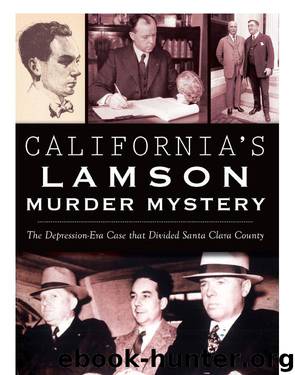California's Lamson Murder Mystery: The Depression Era Case that Divided Santa Clara County (True Crime) by Zaniello Tom

Author:Zaniello, Tom [Zaniello, Tom]
Language: eng
Format: epub
Publisher: Arcadia Publishing Inc.
Published: 2016-10-17T04:00:00+00:00
Title page of The Case of David Lamson: A Summary , published by the Lamson Defense Committee, 1934. Author’s collection .
Film poster for Christine of the Hungry Heart (1924), based on a bestselling novel by Kathleen Norris about the “new woman” of the 1920s who refuses to conform. Courtesy Margaret Herrick Library, Academy of Motion Picture Arts and Sciences .
The rally was an ambitious undertaking, with broad support from the religious community, Stanford University and the entire San Francisco Bay area. A pre-rally showing of Lamson family home movies, taken shortly before Allene’s death, was designed to show Bay Area clergy “just what happened in the Lamson home as far as possible.”
Winters chaired the rally of more than five hundred people at the San Francisco Masonic Temple. He suggested that the tendency of some members of the Stanford University community to continue to “acquiesce in Lamson’s conviction” was a “painful and shocking experience” to him. A university “dedicated to critical opinion” should realize that the evidence made his innocence clear.
Norris’s speech was quite personal: she confessed that she at first thought that Lamson was guilty. She planned to attend the first trial to gather material, as was her habit, for a future story or article. As one of the “completely biased and the completely ignorant,” she was at first driven by a “terrible impulse to hunt down and avenge.” After flaws in the state’s evidence were pointed out to her, she realized how wrong she had been. Her support of the Lamson Defense Committee’s pamphlet was substantial, but now she added a new donation of $800 (more than $14,000 today) to the defense fund.
Although Vollmer could not attend, his speech was nonetheless read aloud to emphasize that “every shred of physical evidence proves that Allene Lamson’s death was accidental.” The transformation in Lamson’s face as he left off his gardening to meet the real estate agent at the front door—from “flushed with exertion” to “ashen”—alone proves his innocence: “such a change no human being can bring about at will.”
Lamson’s strongest supporters were also busy. A friend gave Winters and his wife, Janet Lewis, a copy of a nineteenth-century classic of jurisprudence, Samuel Phillipps’s Famous Cases of Circumstantial Evidence , to help them with the key legal concept of the prosecution’s case. Lewis went on to adapt three of the chapters into novels, especially the bestselling The Wife of Martin Guerre (1941), which established her reputation as a writer.
Winters was one of the few individuals to carry the analysis of Lamson’s case beyond courtroom rhetoric. Winters never stopped believing that, regardless of the arena, academic or public, “when a stupid man rises to power he becomes pompous, hypocritical and dangerous.” His essay “More Santa Clara Justice” in the New Republic in October 1934 made the Lamson case a national issue.
David Lamson, Winters wrote, was not among “the victims of an economic struggle and of racial prejudice.” Such victims can at least “feel themselves to be martyrs to a cause” and believe that “history, at least, will justify them, whether collectively or individually.
Download
This site does not store any files on its server. We only index and link to content provided by other sites. Please contact the content providers to delete copyright contents if any and email us, we'll remove relevant links or contents immediately.
| Africa | Americas |
| Arctic & Antarctica | Asia |
| Australia & Oceania | Europe |
| Middle East | Russia |
| United States | World |
| Ancient Civilizations | Military |
| Historical Study & Educational Resources |
Cat's cradle by Kurt Vonnegut(14777)
Pimp by Iceberg Slim(13798)
Underground: A Human History of the Worlds Beneath Our Feet by Will Hunt(11846)
4 3 2 1: A Novel by Paul Auster(11812)
The Radium Girls by Kate Moore(11634)
Wiseguy by Nicholas Pileggi(5327)
American History Stories, Volume III (Yesterday's Classics) by Pratt Mara L(5140)
Perfect Rhythm by Jae(5080)
The Fire Next Time by James Baldwin(5025)
Paper Towns by Green John(4808)
Pale Blue Dot by Carl Sagan(4628)
A Higher Loyalty: Truth, Lies, and Leadership by James Comey(4560)
The Mayflower and the Pilgrims' New World by Nathaniel Philbrick(4286)
The Doomsday Machine by Daniel Ellsberg(4250)
Killers of the Flower Moon: The Osage Murders and the Birth of the FBI by David Grann(4194)
Too Much and Not the Mood by Durga Chew-Bose(4098)
The Sympathizer by Viet Thanh Nguyen(4096)
The Borden Murders by Sarah Miller(4029)
Sticky Fingers by Joe Hagan(3916)
